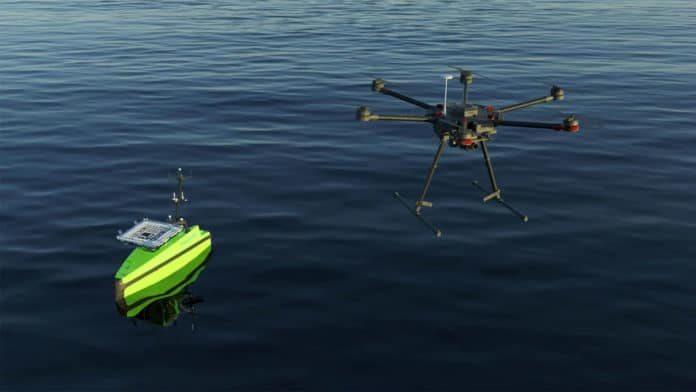Drones are convenient to use for a quick survey of a large area, but their relatively low speed and flight time lead to a shorter range. This is why the drones can only be used near a place where they can be deployed and recharged.
TideWise and STABLE have announced successful testing of their ARIEL project, which saw a drone autonomously take off from the USV Tupan. The vessel can be used as a base for landing and recharging the drone. Developed over the past two years, TideWise managed the project from concept to prototype demonstration.
The ARIEL project, which was developed in partnership with Repsol Sinopec Brasil, GSCAR – COPPE/UFRJ, and Farol, consisted in the integration of a drone (UAV) and an unmanned surface vehicle (USV) to efficiently detect and identify oil spills without the need for any human operators. Equipped with visual cameras to locate leaks and visual and thermal cameras for oil detection, the drone takes off from a platform installed on the USV Tupan vessel.
During the tests, the USV Tupan – a small unmanned boat with a length of just under five meters – was equipped with a stabilized launch pad from STABLE, which allowed the drone to stay flat no matter the conditions on the water. It is driven by two electric motors, two rudders, and a diesel-electric generator. As a drone, the engineers used a hexacopter with large landing legs and a bottom-facing camera. Before landing, the ship and the drone communicated with one another to share key information like their location in an effort to make landing a little easier.
The vehicles work autonomously and collaboratively, and the integrated system allows continuous monitoring and rapid detection of oil spills at sea. The integration of meteoceanographic sensors makes it possible to integrate them with the existing oil dispersion models, enabling predictive analyzes. In addition, ARIEL’s double-check allows for a more reliable analysis than the method mostly used by the oil industry, which uses satellite images.
“One of the project’s main challenges was accomplishing a safe UAV landing on a moving USV,” Rafael Coelho, Managing Director of TideWise, commented. “Based upon a bespoken flexible design, low power consumption, long-time stabilization references, and a proactive engineering team, the STABLE platform was selected for our project as it removed most of the rolling and pitching motions for securing a successful landing.”
